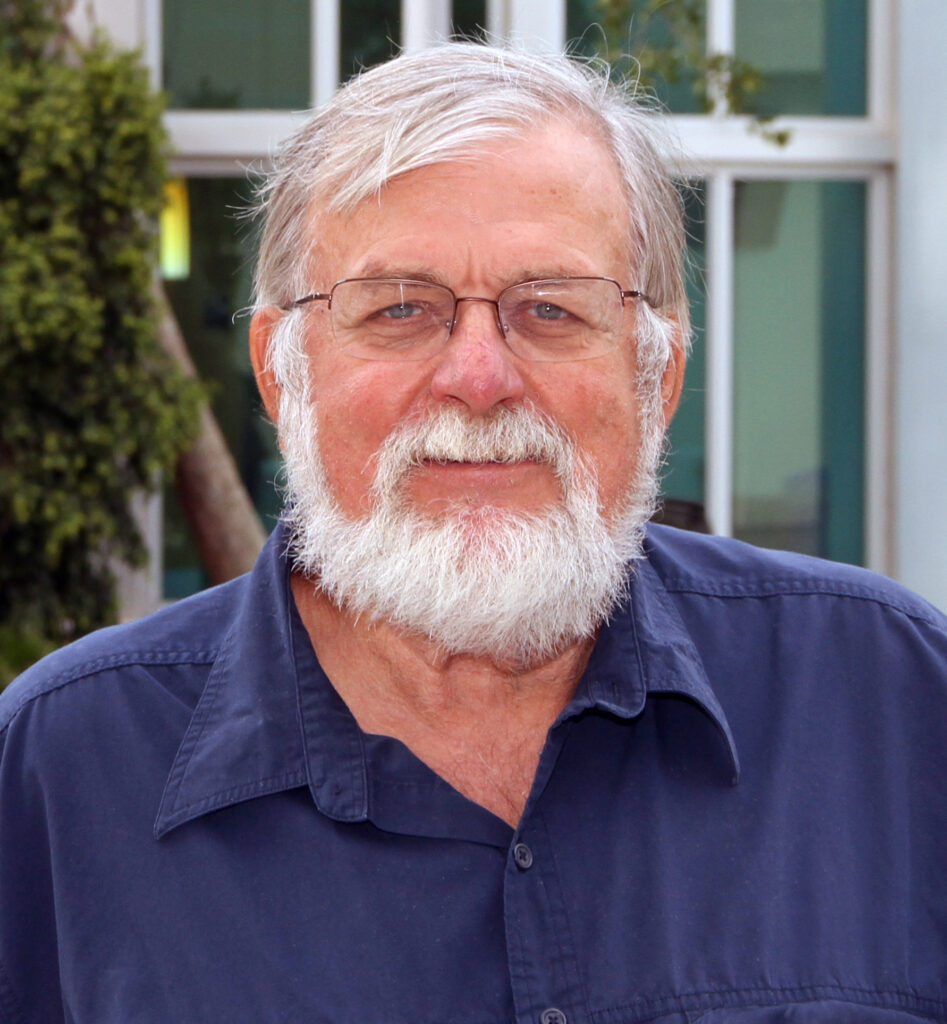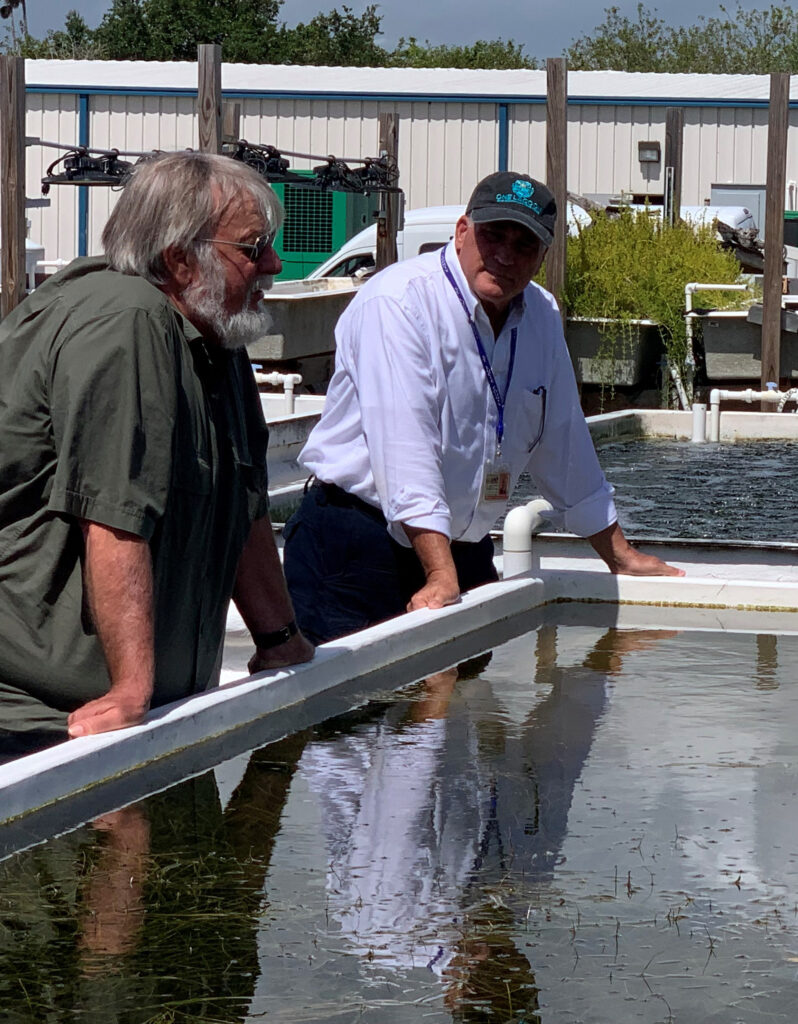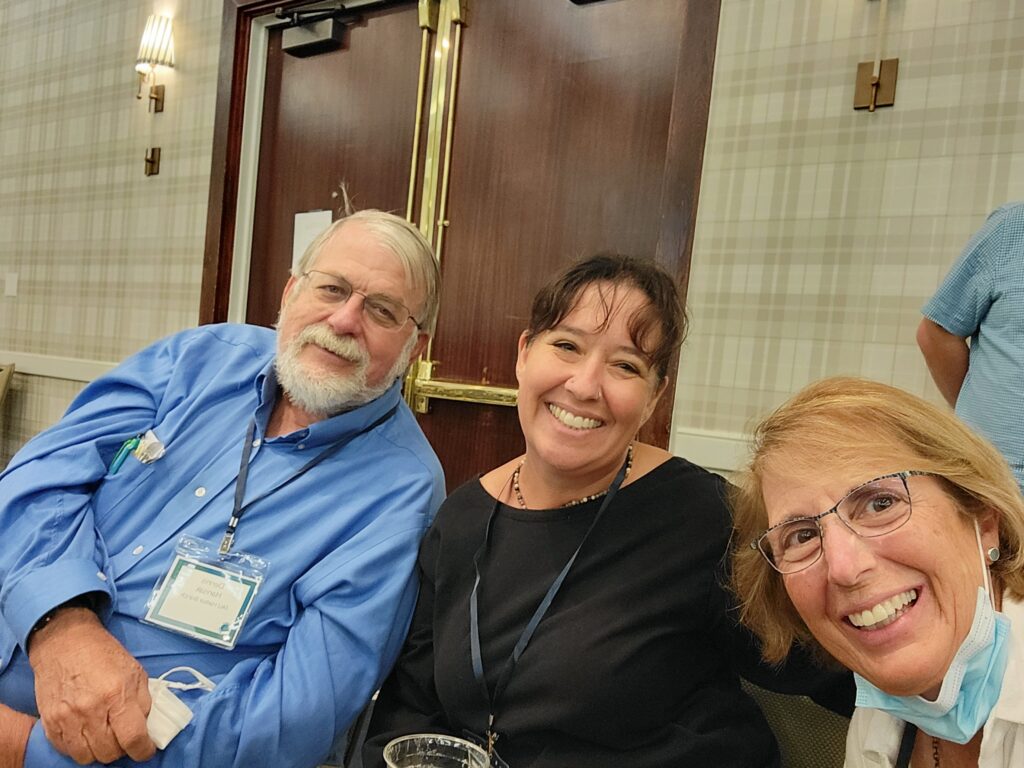By Natalie van Hoose
Dennis Hanisak hovered above rows of seagrass seedlings, counting shoots by feel in hazy brown water that limited visibility to a few inches. His head emerged from the Indian River Lagoon, rivulets streaming down his snorkel mask.
“Ninety and spreading,” he said. A student recorded the number on a clipboard.
“Something’s eating it. We’re going to have to investigate that.” Hanisak carried his quadrat – a square PVC frame – down the experimental plot where he was testing whether seagrass, clams and oysters could boost each other’s survival rates in the estuary, where all have suffered dramatic declines. It was September 2021 and hot, and grasshoppers churred on nearby Samsons Island.

Hanisak never intended to study seagrass. Originally from New Jersey, he arrived at Harbor Branch Oceanographic Institute, now part of Florida Atlantic University, in 1977 as a postdoctoral researcher of algae and seaweed. Over the years, however, he became a leading authority on the Indian River Lagoon’s seven seagrass species and how they undergird the health of the 156-mile-long waterway, once considered North America’s most biodiverse estuary.
Seagrasses, also known as “coastal canaries” because of their sensitivity to environmental changes, anchor sediment, store carbon and provide the foundation for the Indian River Lagoon’s wildlife. Hanisak underscored their value in public lectures long before a spate of manatee deaths launched the lagoon’s seagrass losses into the national spotlight in 2021.
M. Dennis Hanisak, a research professor and director of education and the marine ecosystems health program at HBOI, died May 7. He was 73.
Hanisak published more than 100 scientific studies and co-authored a book on the Indian River Lagoon’s underwater plants. On a Zoom call last week, seagrass scientists from around the state held up printed copies of his pioneering papers, some decades old. “They all have them on their desk within arm’s reach,” said Lauren Hall, an environmental scientist at the St. Johns River Water Management District.
He created the methods SJRWMD uses to estimate seagrass biomass in the Indian River Lagoon and was the first to set up experimental seagrass nurseries for the estuary, growing the plants in outdoor tanks and tweaking light and nutrients to test their response.
Environmental scientist Lori Morris, who leads SJRWMD’s seagrass monitoring program, recalled a breakfast meeting with colleague Bob Virnstein and Hanisak at a Cocoa Beach Shoney’s to work out a plan for measuring the lagoon’s seagrass and light levels. The trio’s discussions carried through lunch. “When they started setting up the dinner buffet, I was like, ‘We’re done,’” said Morris, who credits Hanisak with the success of the lagoon’s long-term seagrass monitoring programs.

He also served as the hub of the lagoon’s science community and a sounding board for ideas. “He was my go-to guy for the offbeat questions,” said Virnstein, Hanisak’s friend and collaborator for more than 40 years. Seagrass experts statewide relied on his expertise, Morris said. “What would Dennis say?” was a common refrain when the group was brainstorming.
“He was bringing that artistic creativity of thinking into the more constrained framework of good scientific exploration and experimental design,” said Duane De Freese, executive director of the Indian River Lagoon National Estuary Program.
Beginning in 2011, the Indian River Lagoon was hit with a decade-long series of severe algal blooms, supercharged by nutrient pollutants. The blooms triggered fish kills and shaded out seagrass, erasing about 75% of the lagoon’s acreage and upending its ecological balance.
Hanisak, who had tracked seagrass stressors in the lagoon since the 1990s, started testing whether nursery-raised seagrass could help jump-start recovery at strategic locations. He also co-authored a nearly 600-page plan for monitoring the lagoon’s vital signs and managing its health. IRLNEP adopted the plan in 2022.
“I tend to be a wild optimist sometimes,” Hanisak told me in 2021. “I would like to think that we have not passed the tipping point.”
Hanisak also spearheaded the Indian River Lagoon Research Symposium, an annual gathering of the scientific community to share the latest in lagoon research findings, policy and conservation efforts. This year’s symposium featured more than 70 presentations, many of them student-led, a point of pride for Hanisak, a dedicated educator and mentor.
One of Hanisak’s former student interns, Kristen Davis, today manages the Indian River Lagoon Observatory Network of Environmental Sensors, a network he developed to capture and share real-time water-quality data from 13 stations. Hanisak recently installed new sensors to study how acidification, a byproduct of climate change, is shifting the chemistry of the lagoon.
Davis said Hanisak’s passion infected other students as they boated out to spoil islands and shorelines to collect and identify fragments of seagrass and clumps of algae.
“He just enjoyed it so much. I think that was just contagious for all the students,” Davis said.

Hall, advised by Hanisak during her master’s, noted his ability to give people his undivided attention and his patience – even after she accidentally clogged the pipes of his seagrass tanks with discarded algae.
“He was a friend to everyone,” HBOI Executive Director James Sullivan said. “He approached science and education with humor and a lightness that put people at ease.”
HBOI is poised to break ground on Hanisak’s new state-of-the-art seagrass nursery, a greenhouse that will enable scientists to control growing conditions more closely.
“We are committed to continuing all his research and his work,” Sullivan said. “It’s going to take five people to take up aspects of what he did. He dedicated his life to this institution.”
HBOI will host a celebration of Hanisak’s life in late June. Details are forthcoming.
“There are only a handful of icons in the lagoon,” De Freese said. “When you lose those legends, they’re really impossible to replace.”
Natalie van Hoose is a freelance environmental journalist who often writes about the Indian River Lagoon.
Banner photo of Dennis Hanisak courtesy of FAU Harbor Branch Oceanographic Institute. The Invading Sea is managed by FAU’s Center for Environmental Studies and receives support from the FAU Charles E. Schmidt College of Science.
Sign up for The Invading Sea newsletter by visiting here. If you are interested in submitting an opinion piece to The Invading Sea, email Editor Nathan Crabbe at ncrabbe@fau.edu.



